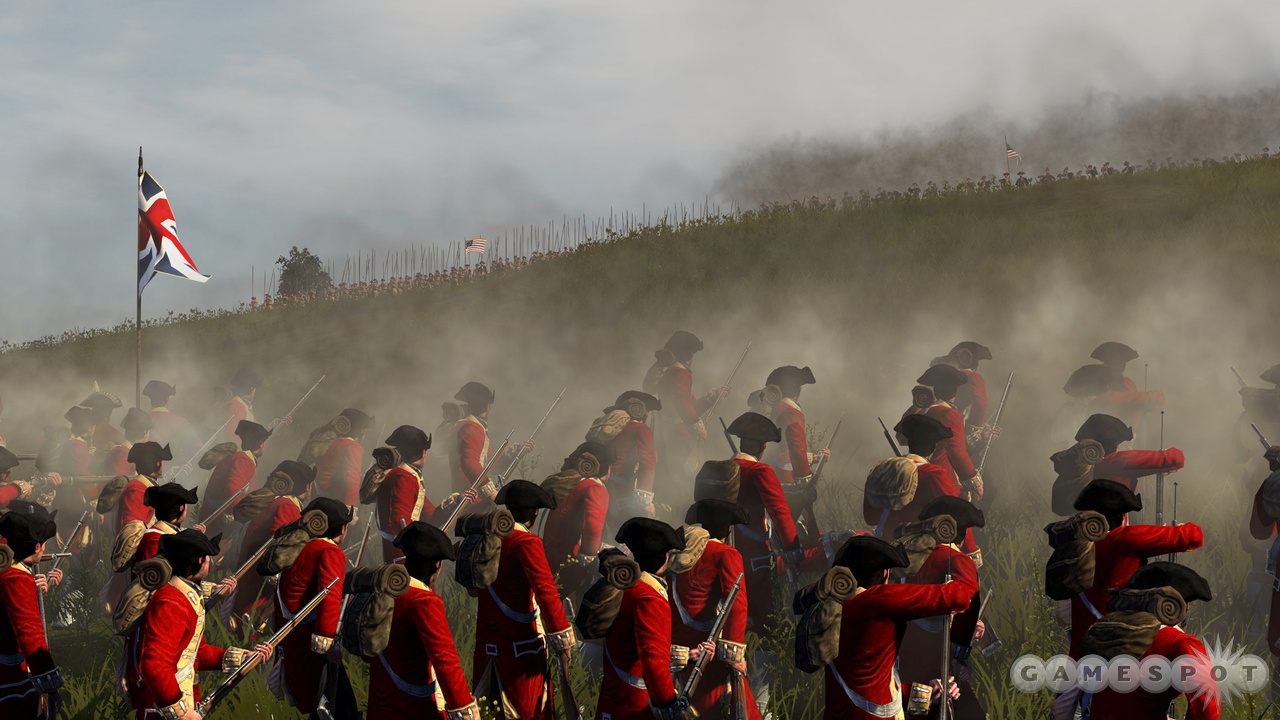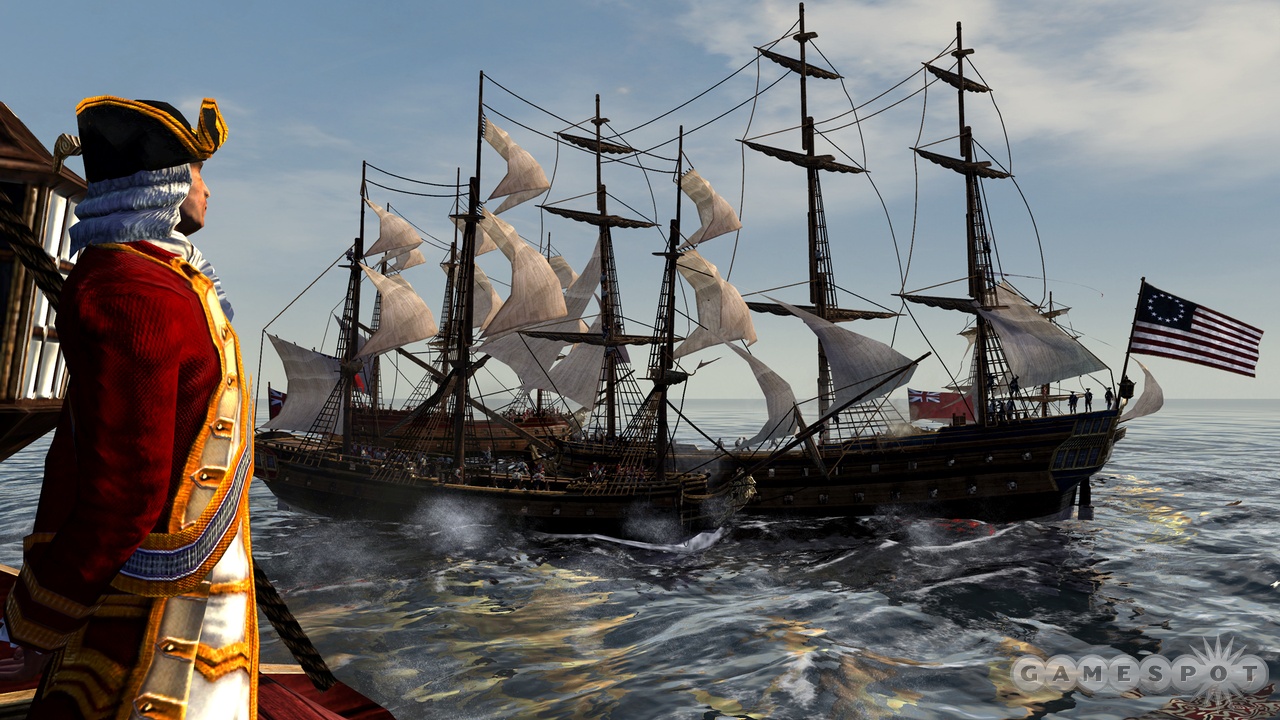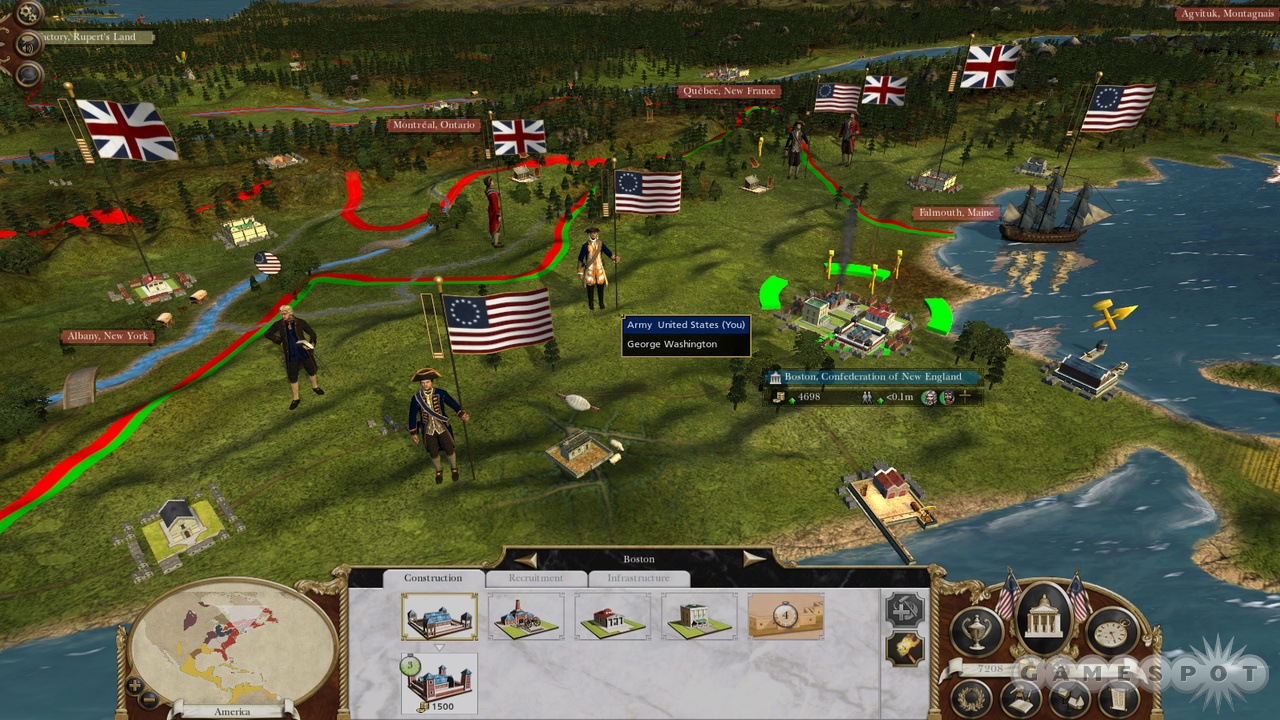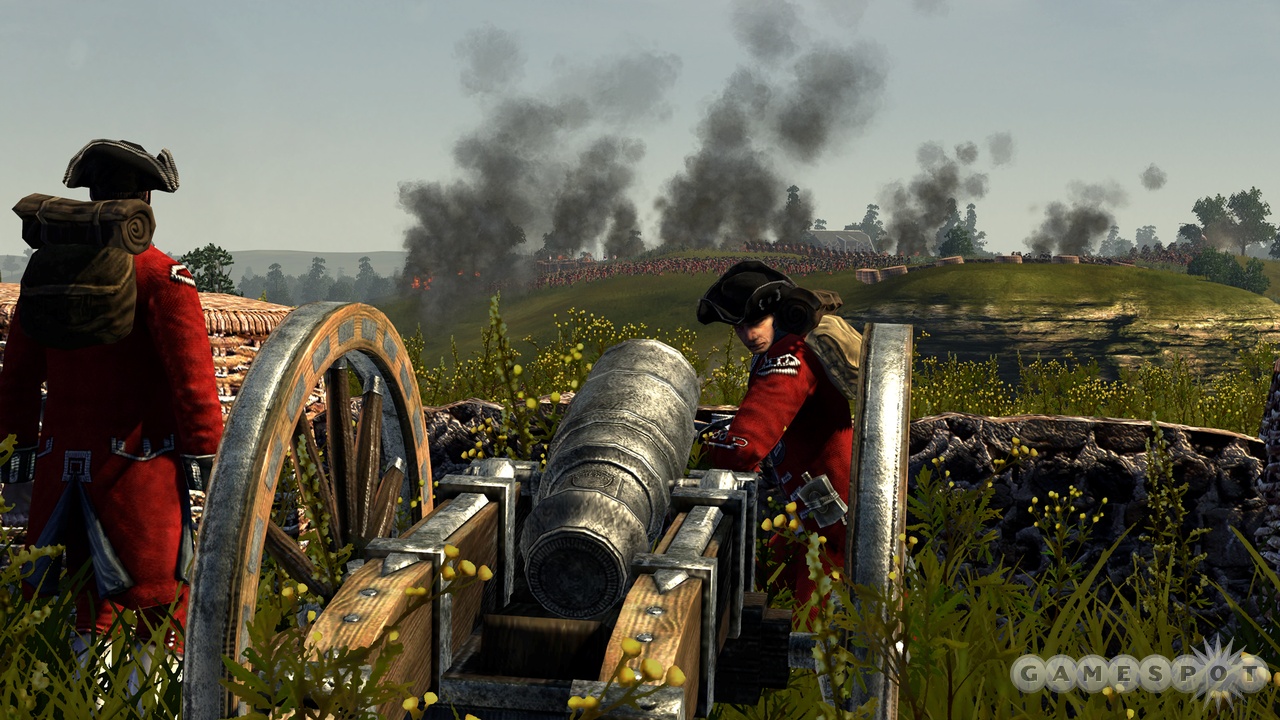Empire: Total War Exclusive Hands-On - Early Campaign, Naval and Land Battles, Managing a Colony
We get our hands on this highly anticipated strategy game, jump into naval and land battles, and try our hand at governing a colony in the New World.
There have been ambitious grand strategy games in the past that have challenged you to create and maintain an empire by managing both military campaigns and peacetime duties, such as trade, diplomacy, and technological research. But none so far have aspired to paint as epic a picture as Creative Assembly's Empire: Total War, which will challenge you to conquer the New World by way of economic supremacy and political skulduggery, by waging massive land-based wars with hundreds of brave foot soldiers, and by waging equally massive naval wars with an armada of cannon-laden vessels. We got our hands on an early version of the game, and we're here to bring you an exclusive look at what you can expect.
In addition to having the opportunity to try out a limited version of the campaign, we had a chance to hop into a preloaded naval battle scenario in which we took control of a small American colonial fleet to take on an enemy fleet of comparable size. Naval battles, like land battles in the Total War series, begin with a deployment phase in which you can place your ships within a certain deployment range before beginning the real-time battle. Maritime skirmishes will take place between ships of various shapes, sizes, and speeds--the largest and most powerful ships will be decked out with dozens of sails and will also command dozens of devastating cannons, and they can also accommodate sizable crews of able-bodied soldiers who will eagerly cast boarding lines onto enemy ships if you prefer to board an enemy vessel. However, these monstrously powerful ships will also have poor turning speed compared to a smaller ship, such as a sloop. Our own fleet consisted of a massive heavy frigate, two third-rate ships of the line, and two 24-pounder frigates--a well-rounded offensive force with a good mix of speed and power. Our opponents, the hated British (present company excepted, of course), started out several leagues north of our position, though the winds were blowing in an easterly direction, which added an interesting wrinkle to the battle.

Because none of Empire: Total War's ships will have an outboard motor or a nuclear reactor, all ships will obey the pull of the sea winds, so it's up to you to line up with tailwinds while avoiding a course straight into headwinds where possible. In the early version of the game we played, ship controls appeared in the bottom right corner of the screen (where unit controls usually appear in Total War games), while the bottom left corner and bottom center of the screen featured a minimap and unit information, respectively--again, like in previous games in the series. You give standard orders to your ships as you would in any real-time strategy game by clicking to select them and giving them move or attack orders with a right click of your mouse, but your unit control panel also includes additional commands for all the ambitious admirals out there who want to give individual sail commands, such as rotating sails port or starboard or setting sail or dropping anchor. The control panel also lets you select your cannons' shot (from standard cannonballs, which attack enemy ships' hulls; chainshot, which tears at enemy sails and brings damaged ships to a standstill; and grapeshot, which kills off enemy ship crews), and it gives "fire at will" commands. You can even toggle port and starboard broadsides on or off.
We made good use of the broadside option by eagerly--and rather rashly--pushing our heavy frigate ahead of the pack to deliver satisfying volley after volley of cannon fire into the enemy fleet, sinking one enemy ship in short order and crippling a second. Naturally, our heavy frigate, by virtue of its many sails, was able to outpace the rest of our fleet in a straight shot toward the enemy, but we soon paid the price for our foolhardy gambit when the remainder of the enemy ships came about and flanked our frigate--and one enemy ship-of-the-line, seemingly out of desperation, rammed our heavy frigate head-on, smashing the tip of our vessel's forward hull to splinters. Like in previous Total War games, hovering your mouse cursor over any unit will reveal quick information about it, such as how damaged or fatigued it is, the action it's currently engaged in (such as firing, fleeing, and so on), and its current morale level. A quick mouseover of our ship revealed that although our ship was indeed damaged, and the crew was concerned about the damage, it remained largely confident.
With our heavy frigate flanked by an enemy ship on one side and blocked from the front by another, we decided to board the British ship next to us--a tactic our lusty and cheering crew heartily approved of. Taking care to hurry our remaining ships forward to sweep up the last of the British ships, we then zoomed our view of the game in on the boarding to watch our dozens of tiny crewmen launch multiple boarding ropes and shimmy across them to engage our enemies hand-to-hand. We claimed victory in the battle in an unnecessarily messy brawl that saw our medium vessels chase down the enemy--a battle that probably could have been less messy had we carefully negotiated the seas and the wind direction, because Empire, like other Total War games before it, physically models the ballistics of all missile weapons, so the crafty British ships turned at odd angles, requiring our ships to turn in reaction to lay broadsides, and occasionally landing fire on our own ships. We admit, we were too engrossed in the pitched battle between our determined crew of seadogs who dueled with the crewmen of the boarded ship. Obviously, the game will allow for more-elegant strategies, but we just couldn't resist the temptation to scoot that heavy frigate forward and broadside the living daylights out of our enemy.

After jumping out of the naval scenario, we then hunkered down with a brief campaign session to try out Empire's turn-based strategic elements. The scenario put us in command of the fledgling colony of Boston, surrounded on all sides by the warring imperialistic nations of France (holding colonies that would later become Ontario and Quebec) and England (holding colonies like Albany, New York, and their capital, Philadelphia, Pennsylvania) and by the as-yet unprovoked Native American Iroquois and Algonquin nations (occupying colonies like Cayuga and Niagara). As the American colonists, we were clearly overmatched, but with the heart of a patriot beating in our chest (and the Escape key at the ready to reload a saved game), we dove into our task of building up our tiny colony to eventually become an emancipated nation.
Like other Total War games, Empire has a turn-based strategic layer that lets you manage your holdings, economy, research, political structure, and armies, and in this case, the turns are biannual, representing the military campaign seasons of summer and winter. Empire's strategic layer seems at once more streamlined and also more in-depth, and it even has a helpful voice-over that plays the first time you open up a new menu. Essentially, you need to manage the economy, government, diplomacy, structural (and infrastructural) development, and technological development--as well as the military development--of your colonies, and you'll do so through a set of nested menus that live in the lower right corner of the screen, just like in other Total War games. However, like in other games in the series, all civic upgrades are tied in to each other, such that investing the time and turns into one development may benefit your nation in other ways--upgrading your roads, for instance, not only will increase your trade revenues from neighboring cities, but will also improve the overland marching speed of your infantry companies.

Economic development takes place in the form of colonial taxation (which you can adjust with a simple slider to increase, bringing more money into your coffers but fomenting more popular dissent, or decrease, making people happier but bringing less money into the treasury) and also in the form of enhanced trade, either with neighboring settlements or with any Old World trading nations with whom you may have an agreement, in the form of crops and other New World commodities, such as sugar, tobacco, ivory, furs, spices, and tea. Economics tie directly in to local government, since the general happiness of the populace directly affects your agricultural output, and the legal and financial policies your governors implement will determine your tax and labor policies. Fortunately, technological research (which occurs along a "technology tree" independently of what's going on in your cities) can introduce better, more-efficient types of labor and business practices to make your nation richer and happier, though because you can research only one item at a time, you'll need to choose wisely from three different research branches of military, economic, and philosophical--which will unlock better tools for the battlefield (more-advanced muskets, bayonets, grenades, and better tactical formations), new structural upgrades for key economic buildings, and new sociopolitical and economic policies that will affect your society as a whole. The coins in your nation's collective pocket will also determine your stature when it comes to diplomacy, since in addition to standard military alliances, you can propose trade alliances, make national gifts, and trade entire regions to your partners, as well as demand protectorate status, which, if accepted, will require the subject nation to forfeit half of its profits to you and preclude it from declaring war (unless the nation decides to rebel and declare war on you). Of course, demanding a protectorate will be more a matter of military might.

We had a chance to flex our military muscles in our limited campaign time by taking an experienced American general known as George Washington and several companies of light infantry and dragoon cavalry (mounted infantry that can dismount and fight on foot) into battle to capture Albany. We used the deployment phase to line up our troops as close to the fore as possible, putting General Washington and his cavalry honor guard a bit further in the back. When the battle itself started, we brought all our troops forward in lockstep in a single line (perhaps not the smartest tactic, but good for getting into the action quickly) to see what it was like when soldiers collide. Like in all Total War games, Empire's land battles, even the small ones at the start of the game, are massive and are viewed from the perspective of a godlike spectator hovering above the battlefield. Empire does have rock-paper-scissors-like unit balancing in that light infantry handily beat militia, heavy infantry beat light infantry, and pike emplacements beat cavalry (which we remembered only too late after hastily steering some of our dragoons around some fenced-off emplacements to cut off a routed enemy squad's retreat...only to get gored). Like with naval battles, you can hover your mouse over a company to get a sense of its status and morale, and because we had built up a decent number of low-level infantry units to outclass the local British militia, we were able to get many of them to route (flee) in short order. Routed enemies have a flashing white flag icon that hovers over their heads, and they will often break and run, giving you the option to pursue them or to turn your pursuing forces' attention to other enemy squads. The land battle was much more orderly than our naval experience because we had slightly larger and more-powerful armies that were able to flank our foes and eventually cause them to break ranks and flee.
From all appearances, Empire: Total War will have every bit of the strategic depth of its forebears with more-streamlined interfaces, intriguing new naval battles, and a brand-new setting where the Age of Sail hasn't quite ended and where guns and cannons begin to rise to prominence in modern warfare. Stay tuned to GameSpot for more updates on this promising strategy sequel.
Got a news tip or want to contact us directly? Email news@gamespot.com
Join the conversation